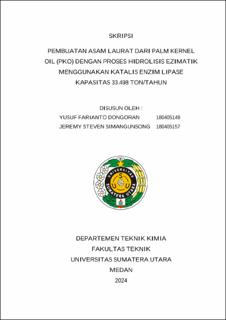Pembuatan Asam Laurat dari Palm Kernel Oil (PKO) dengan Proses Hidrolisis Ezimatik Menggunakan Katalis Enzim Lipase Kapasitas 33.498 Ton/Tahun
Manufacturing Lauric Acid from Palm Kernel Oil (PKO) with Enzymatic Hydrolysis Process Uses Enzyme Catalyst Lipase Capacity 33,498 Ton/Year

Date
2024Author
Dongoran, Yusuf Farianto
Simangunsong, Jeremy Steven
Advisor(s)
Hasibuan, Rosdanelli
Metadata
Show full item recordAbstract
Indonesia, as the country ranked first in the world for producing palm oil and with the largest plantation area, means that this agricultural country has the largest commodity assets, namely palm oil products and their derivatives. One of the palm oil derivative products is palm kernel oil (PKO). The availability of PKO in Indonesia is very abundant, the Directorate General of Plantations noted that in 2022 the availability of PKO in Indonesia will reach 9,647,081 tonnes from the plantation area throughout Indonesia of 14,456,611 Ha.
PKO has a high lauric acid content, namely 48-50% and this value can be higher than coconut oil which also has high lauric acid levels. Lauric acid is useful as a raw material for making detergents, cosmetics and even antibacterials. Lauric acid is an oleochemical product, in this case oleochemicals are categorized as one of the priority types of upstream industry in the 2015-2035 National Industrial Development Master Plan (RIPIN). So there needs to be special attention in supporting government programs by implementing one of the design programs that have been prepared for the progress of the nation and state.
The hydrolysis reaction took place at a temperature of 100°C, saturated steam of 3 bar, and a reaction time of 72 hours, with a conversion of 90%. Saturated steam is flowed into the hydrolysis tank (R101) so that the desired operating conditions can be achieved. In this reactor (R101) a hydrolysis reaction or breakdown of the alkyl group in triglycerides (PKO) will occur with water and the lipase enzyme catalyst to become PKO-FA (Palm Kernel Fatty Acid) and Sweat water (glycerol). This reaction produces PK-FA which flows upwards and glycerol flows downwards. The glycerol is then fed to flash tank I (D-201) to reduce the water content, pressure and temperature from 40°C to 100°C xii under vacuum. After leaving flash tank I, the raw glycerol flows to the final glycerol storage tank (TT-201). The resulting PK-FA is fed to flash tank II (D-202) to reduce the water content, pressure and temperature from 40°C to 100°C under vacuum. The results of the pre-design economic lauric acid using Palm Kernel Oil (PKO) as raw material through an enzymatic hydrolysis process are:
• Investment Capital = IDR 300.922.005.568
• Production costs per year = IDR 1.141.468.224.042
• Product selling price per year = IDR 1.459.135.893.479
• Net profit per year = IDR 119.744.532.085
• Profit Margin (PM) = 12 %
• Break Even Point (BEP) = 46 %
• Return on Investment (ROI) = 20 %
• Pay Out Time (POT) = 5,027 tahun
• Return on Network (RON) = 33 %
• Internal Rate of Return (IRR) = 27,14 %
From the results of the economic analysis, it can be concluded that the pre-designed factory lauric acid using Palm Kernel Oil (PKO) as raw material through an enzymatic hydrolysis process is feasible to establish
Collections
- Undergraduate Theses [1239]
